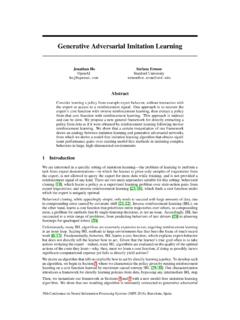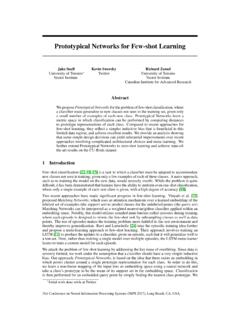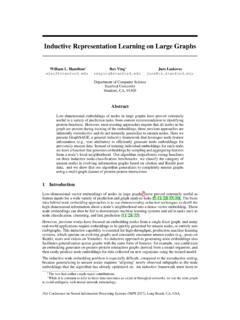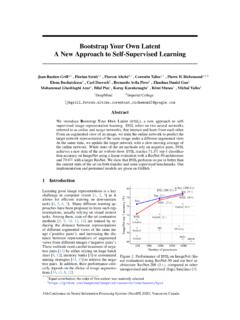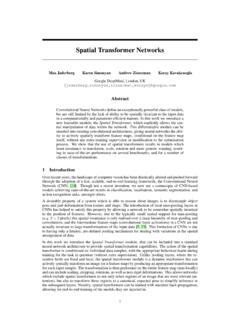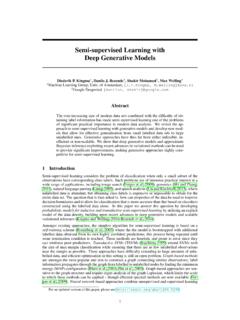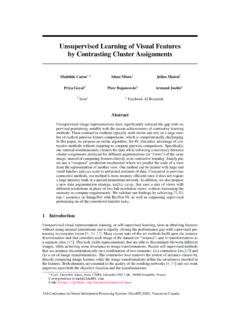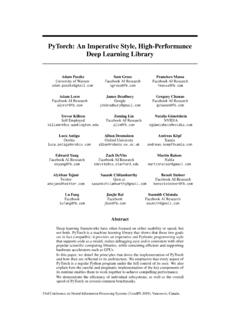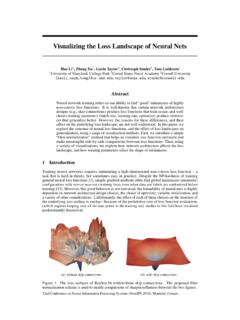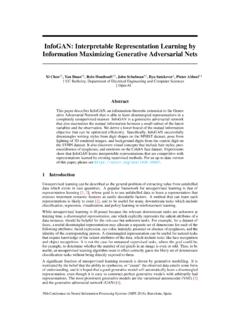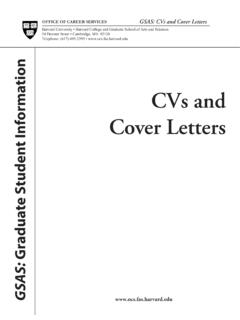Transcription of Man is to Computer Programmer as Woman is to ... - NeurIPS
1 Man is to Computer Programmer as Woman is toHomemaker? Debiasing Word EmbeddingsTolga Bolukbasi1,Kai-Wei Chang2,James Zou2,Venkatesh Saligrama1,2,Adam Kalai21 Boston University, 8 Saint Mary s Street, Boston, MA2 Microsoft Research New England, 1 Memorial Drive, Cambridge, blind application of machine learning runs the risk of amplifying biases presentin data. Such a danger is facing us withword embedding, a popular framework torepresent text data as vectors which has been used in many machine learning andnatural language processing tasks. We show that even word embeddings trained onGoogle News articles exhibit female/male gender stereotypes to a disturbing raises concerns because their widespread use, as we describe, often tends toamplify these biases. Geometrically, gender bias is first shown to be captured bya direction in the word embedding. Second, gender neutral words are shown tobe linearly separable from gender definition words in the word embedding.
2 Usingthese properties, we provide a methodology for modifying an embedding to removegender stereotypes, such as the association between the wordsreceptionistandfemale, while maintaining desired associations such as between the wordsqueenandfemale. Using crowd-worker evaluation as well as standard benchmarks, weempirically demonstrate that our algorithms significantly reduce gender bias inembeddings while preserving the its useful properties such as the ability to clusterrelated concepts and to solve analogy tasks. The resulting embeddings can be usedin applications without amplifying gender IntroductionResearch on word embeddings has drawn significant interest in machine learning and natural languageprocessing. There have been hundreds of papers written about word embeddings and their applications,from Web search [22] to parsing curriculum vitae [12]. However, none of these papers haverecognized how blatantly sexist the embeddings are and hence risk introducing biases of varioustypes into real-world word embedding, trained on word co-occurrence in text corpora, represents each word (or commonphrase)was ad-dimensionalword vector~w2Rd.
3 It serves as a dictionary of sorts for computerprograms that would like to use word meaning. First, words with similar semantic meanings tend tohave vectors that are close together. Second, the vector differences between words in embeddingshave been shown to represent relationships between words [27,21]. For example given an analogypuzzle, man is to king as Woman is tox (denoted asman:king:: Woman :x), simple arithmetic ofthe embedding vectors finds thatx=queenis the best answer because !man ! Woman !king ! ,x=Japanis returned forParis:France::Tokyo:x. It is surprising that a simple vectorarithmetic can simultaneously capture a variety of relationships. It has also excited practitionersbecause such a tool could be useful across applications involving natural language. Indeed, theyare being studied and used in a variety of downstream applications ( , document ranking [22],sentiment analysis [14], and question retrieval [17]).
4 However, the embeddings also pinpoint sexism implicit in text. For instance, it is also the case that: !man ! Woman ! Computer Programmer ! other words, the same system that solved the above reasonable analogies will offensively answer man is to Computer Programmer as Woman is tox withx=homemaker. Similarly, it outputs that a30th Conference on Neural Information Processing Systems (NIPS 2016), Barcelona, homemaker2. nurse3. receptionist4. librarian5. socialite6. hairdresser7. nanny8. bookkeeper9. stylist10. housekeeperExtremehe1. maestro2. skipper3. protege4. philosopher5. captain6. architect7. financier8. warrior9. broadcaster10. magicianGender stereotypeshe-heanalogiessewing-carpentr y registered nurse-physician housewife-shopkeepernurse-surgeoninterio r designer-architectsoftball-baseballblond -burlyfeminism-conservatismcosmetics-pha rmaceuticalsgiggle-chuckle vocalist-guitaristpetite-lankysassy-snap pydiva-superstarcharming-affablevolleyba ll-football cupcakes-pizzaslovely-brilliantGender appropriateshe-heanalogiesqueen-kingsist er-brothermother-fatherwaitress-waiter ovarian cancer-prostate cancer convent-monasteryFigure 1:LeftThe most extreme occupations as projected on to theshe hegender direction onw2vNEWS.
5 Occupations such asbusinesswoman, where gender is suggested by the orthography,were generated analogies for the pairshe-heusing the proceduredescribed in text. Each automatically generated analogy is evaluated by 10 crowd-workers to whetheror not it reflects gender to adoctoras amotheris to anurse. The primary embedding studied in this paper is thepopular publicly-available word2vec [19,20] 300 dimensional embedding trained on a corpus ofGoogle News texts consisting of 3 million English words, which we refer to here as the might have hoped that the Google News embedding would exhibit little gender bias becausemany of its authors are professional journalists. We also analyze other publicly available embeddingstrained via other algorithms and find similar biases (Appendix B).In this paper, we quantitatively demonstrate that word-embeddings contain biases in their geometrythat reflect gender stereotypes present in broader to their wide-spread usage as basicfeatures, word embeddings not only reflect such stereotypes but can also amplify them.
6 This poses asignificant risk and challenge for machine learning and its applications. The analogies generated fromthese embeddings spell out the bias implicit in the data on which they were trained. Hence, wordembeddings may serve as a means to extract implicit gender associations from a large text corpussimilar to how Implicit Association Tests [11] detect automatic gender associations possessed bypeople, which often do not align with self quantify bias, we will compare a word vector to the vectors of a pair of gender-specific words. Forinstance, the fact that !nurseis close to !womanis not in itself necessarily biased(it is also somewhatclose to !man all are humans), but the fact that these distances are unequal suggests bias. To makethis rigorous, consider the distinction betweengender specificwords that are associated with a genderby definition, and the remaininggender neutralwords. Standard examples of gender specific wordsincludebrother,sister,businessmanan dbusinesswoman.
7 We will use the gender specific words tolearn a gender subspace in the embedding, and our debiasing algorithm removes the bias only fromthe gender neutral words while respecting the definitions of these gender specific propose approaches to reduce gender biases in the word embedding while preserving the usefulproperties of the embedding. Surprisingly, not only does the embedding capture bias, but it alsocontains sufficient information to reduce this will leverage the fact that there exists a lowdimensional subspace in the embedding that empirically captures much of the gender Related work and PreliminaryGender bias and stereotype in is important to quantify and understand bias in languagesas such biases can reinforce the psychological status of different groups [28]. Gender bias in languagehas been studied over a number of decades in a variety of contexts (see, , [13]) and we onlyhighlight some of the findings here.
8 Biases differ across people though commonalities can be Association Tests [11] have uncovered gender-word biases that people do not self-report andmay not even be aware of. Common biases link female terms with liberal arts and family and maleterms with science and careers [23]. Bias is seen in word morphology, , the fact that words such as1 Stereotypes are biases that are widely held among a group of people. We show that the biases in the wordembedding are in fact closely aligned with social conception of gender stereotype, as evaluated by workers on Amazon s Mechanical Turk. The crowd agreed that the biases reflected both in the location ofvectors ( !doctorcloser to !manthan to ! Woman ) as well as in analogies ( ,he:coward::she:whore.) exhibitcommon gender , by default, associated with the dominant class [15], and female versions of these words, ,actress, are marked. There is also an imbalance in the number of words with F-M with variousassociations.
9 For instance, while there are more words referring to males, there are many more wordsthat sexualize females than males [30]. Consistent biases have been studied within online contextsand specifically related to the contexts we study such as online news ( , [26]), Web search ( ,[16]), and Wikipedia ( , [34]).Bias within number of online systems have been shown to exhibit various biases,such as racial discrimination and gender bias in the ads presented to users [31,4]. A recent studyfound that algorithms used to predict repeat offenders exhibit indirect racial biases [1]. Differentdemographic and geographic groups also use different dialects and word-choices in social media[6]. An implication of this effect is that language used by minority group might not be able to beprocessed by natural language tools that are trained on standard data-sets. Biases in the curation ofmachine learning data-sets have explored in [32, 3].
10 Independent from our work, Schmidt [29] identified the bias present in word embeddings andproposed debiasing by entirely removing multiple gender dimensions, one for each gender pair. Hisgoal and approach, similar but simpler than ours, was to entirely remove gender from the is also an intense research agenda focused on improving the quality of word embeddings fromdifferent angles ( , [18,25,35,7]), and the difficulty of evaluating embedding quality (as comparedto supervised learning) parallels the difficulty of defining bias in an machine learning, a body of notable work has focused on fair binary classification inparticular. A definition of fairness based on legal traditions is presented by Barocas and Selbst [2].Approaches to modify classification algorithms to define and achieve various notions of fairnesshave been described in a number of works, see, , [2,5,8] and a recent survey [36]. The priorwork on algorithmic fairness is largely for supervised learning.
